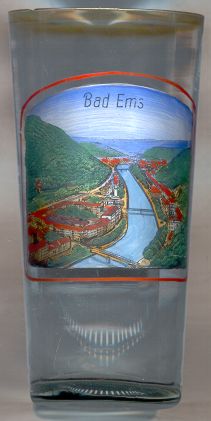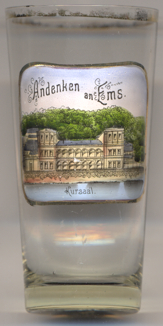

|
| DEUTSCHLAND | GERMANY |
| Bundesland: Rheinland-Pfalz | Rhineland-Palatinate |
| Landkreis: Rhein-Lahn-Kreis |
 Bad Ems is situated at an elevation of 82 m on the river Lahn, about 8 km southeast of Koblenz
in Germany's state of Rhineland-Palatinate. Bad Ems is the administrative seat of the Rhein-Lahn-Kreis (Rhine-Lahn district).
The municipality has a population of about 9,700 (2018).
Bad Ems is situated at an elevation of 82 m on the river Lahn, about 8 km southeast of Koblenz
in Germany's state of Rhineland-Palatinate. Bad Ems is the administrative seat of the Rhein-Lahn-Kreis (Rhine-Lahn district).
The municipality has a population of about 9,700 (2018).
The Romans had already built a fort here where the border of the Roman empire, the Limes, crossed the river. The fort was then abandoned around AD 160. A Frankish settlement began to develop during the 6th century. The first mention of Aumenzu in a document dates from AD 880. Already in 1324, the village received certain privileges, but did not yet obtain the status of a town. Mining for silver had already been mentioned in documents as early as 1158 and continued until the early 20th century. Bad Ems, however, is best known as a spa. The earliest reports of this function date from 1320/1350. Bad Ems thus is one of the oldest spas in Europe. In 1712/1714 the Princes of Nassau-Orange built a manor house in Baroque style which later was also used by the spa. A casino was opened soon after that, in 1720. In the 19th century, Ems was one of the most prestigious spas. Among its numerous guests were emperors, kings and czars. From 1858 on, the famous composer Jacques Offenbach was in charge of the summer theater. In 1863, Ems obtained the status of a town. The predicate 'Bad' was added to its name in 1913. In 2021, Bad Ems was listed by UNESCO as a World Cultural Heritage site (see list) as one of the "Great Spas of Europe", together with Baden (Austria), Spa (Belgium), Františkovy Lázně, Karlovy Vary and Mariánské Lázné (Czech Republic), Bad Kissingen and Baden-Baden (Germany), Montecatini Terme (Italy), and Bath (United Kingdom).
 An event that had hapened in Bad Ems had sparked the Franco-German War of 1870/1871, which eventually led to the foundation of the German Empire.
King Wilhelm I of Prussia had stayed at Ems for a cure and on 13th July was addressed by the French ambassador who tried to gain from the king a guarantee
that in futture no prince of the Hohenzollern family would raise claims to the Spanish throne. This was politely rejected by the king. A diplomat reported this
event to the German chancellor, Otto von Bismarck. Bismarck then published the content of the telegram, but deliberately shortened it so that the
French government felt insulted and on 19th July declared war on Germany. Already on 1st September 1870, France was defeated decisively at Sedan;
Emperor Napoleon III was captured by the German troops, which resulted in the proclamation of the Third French Republic.
Nevertheless, the war lasted on. On 18th January 1871, Wilhelm I was proclaimed German Emperor in Versailles. The city of
Paris surrendered on 28th January. The Treaty of
Frankfurt am Main formally ended the war on 10th May 1871.
Bismarck's version of the telegram later became known as the 'Emser Depesche'.
An event that had hapened in Bad Ems had sparked the Franco-German War of 1870/1871, which eventually led to the foundation of the German Empire.
King Wilhelm I of Prussia had stayed at Ems for a cure and on 13th July was addressed by the French ambassador who tried to gain from the king a guarantee
that in futture no prince of the Hohenzollern family would raise claims to the Spanish throne. This was politely rejected by the king. A diplomat reported this
event to the German chancellor, Otto von Bismarck. Bismarck then published the content of the telegram, but deliberately shortened it so that the
French government felt insulted and on 19th July declared war on Germany. Already on 1st September 1870, France was defeated decisively at Sedan;
Emperor Napoleon III was captured by the German troops, which resulted in the proclamation of the Third French Republic.
Nevertheless, the war lasted on. On 18th January 1871, Wilhelm I was proclaimed German Emperor in Versailles. The city of
Paris surrendered on 28th January. The Treaty of
Frankfurt am Main formally ended the war on 10th May 1871.
Bismarck's version of the telegram later became known as the 'Emser Depesche'.
The  Kursaal [near left, no. 3789]
designed by Johann Gottfried Gutensohn, was built in 1835–1849. A collonade connected it to the Kurhaus building
that had already been built in 1715. In 1866 the spa came in possession of the Prussian state. The complex was renovated
and extended in historistic Baroque revival style in 1912/1913.
Kursaal [near left, no. 3789]
designed by Johann Gottfried Gutensohn, was built in 1835–1849. A collonade connected it to the Kurhaus building
that had already been built in 1715. In 1866 the spa came in possession of the Prussian state. The complex was renovated
and extended in historistic Baroque revival style in 1912/1913.
[https://de.wikipedia.org/wiki/Bad_Ems; https://de.wikipedia.org/wiki/Kurhaus_(Bad_Ems)]
![[scale]](lineal.jpg)